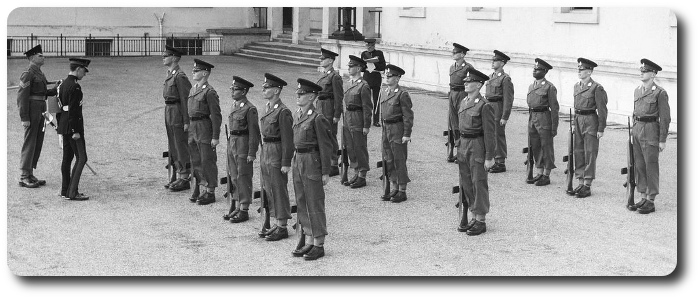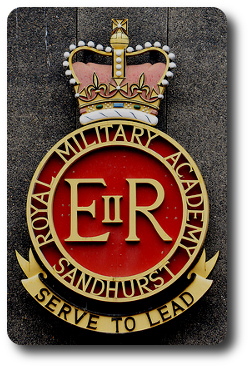Topic: Drill and Training

1960 - The Royal Military Academy, Sandhurst; Intake 28. Junior's Drill Cometition. The Inspection!, posted to flickr by Brian Harrington Spier
Basic Officer Training; Sandhurst
Quoted in To Revel in God's Sunshine; The story of the Army career of the late [Sandhurst] Academy Sergeant Major J.C. Lord, MVO, MBE, compiled by Richard Alford
 Consequently, under the enthusiastic control of Sgt. John France, Scots Guards, we began our drill training on the second day — before we had any uniforms! I remember thinking how my calf-leather shoes were standing up to the punishment. Every opportunity was taken for a few minutes drill as we waited, for example, for kit issues. The training got under way. Two periods of drill a day, two of physical training, the next made up of weapon training, map reading and basic infantry skills. We were up at 6.30, washed, shaved, bed made and dressed for BRC or Breakfast Roll Call Parade, at 07.00. On this parade we had to be immaculate or be punished.
Consequently, under the enthusiastic control of Sgt. John France, Scots Guards, we began our drill training on the second day — before we had any uniforms! I remember thinking how my calf-leather shoes were standing up to the punishment. Every opportunity was taken for a few minutes drill as we waited, for example, for kit issues. The training got under way. Two periods of drill a day, two of physical training, the next made up of weapon training, map reading and basic infantry skills. We were up at 6.30, washed, shaved, bed made and dressed for BRC or Breakfast Roll Call Parade, at 07.00. On this parade we had to be immaculate or be punished.
During the first six weeks there were many ways in which we could get into trouble — from BRC to lights out at 11 p.m. we negotiated what seemed to be a continuous minefield of potential disaster. The smallest fault in turnout meant 'show parades'. The inspecting cadet NCO would pick a fault and say, "Show belt brasses" or "Show boots" as appropriate, and that meant that in addition to the rigours of evening work, the unfortunate junior would parade in a specified uniform at 10 p.m., carrying the offending article suitably prepared for a second inspection. Failure to get on parade on time, or being generally scruffy and disordered in dress, were the juniors' ticket to 'changing parades'. The senior cadets would stand after supper in 'Picadilly', the concourse of the four platoon corridors, in the company block, and the first parade would be called. Out would come the juniors from their doors — "Stand to your doors juniors" was the call — and be inspected. Then they would be told the next form of dress and to parade in five minutes for another inspection. Usually it would go from Service Dress to Combat Dress to PT Kit to Battle Order and so on. In each inspection you could be checked and given extra changing parades as a result. When we got to rifle inspection the situation became even more precarious. We had to parade with rifles 'dry cleaned' meaning not a scrap of oil on them anywhere and achieved by using liquid stain remover 'thawpit', and a stiff brush. On the order "Strip the rifles for inspection" we had to take it apart without putting any of the eight basic pieces down. Always somebody dropped a component and depending on the mood of the Cadet NCO, he or the whole platoon had to do it again. Having satisfied the inspection team, rifles had to be re-oiled and reinspected along similar lines of discipline.
All this 'harrassment', as the Americans call it, went on after a full and exhausting day's work and was in addition to room inspections and cleaning muddy gear after periods on the training area.
I remember noting the ironical comment of our Sergeant Major, when he was showing us how to polish boots. He said that best boots had to be polished all over to a glassy shine, including the welts, and the soles had to be brush polished. However we were on no account to polish the studs, because that was 'bull' and not allowed in the army of the 60s!
After work we would spend hours polishing boots. We had three pairs — weapon training (brush polished only), drill (toes and heels polished), uppers (brush polished), and best — every bit polished. We were not allowed out of uniform at any time during the day. We wore plain clothes once, after about four weeks when we were allowed a couple of hours on Saturday afternoon to attend the Horse Show in the grounds — then back into it. Seven days a week and church parade on Sunday. No old soldier will need to be reminded of the methods used to clean uniform and equipment but for the record and for the uninitiated, the glassy shine was achieved on leather boots with a polish painstakingly applied with the index finger cloaked in a yellow duster. The technique was to dab the duster in polish, spit on the boot and rub in the polish in a small circular motion until, after what seemed an eternity, a shine would begin to appear. It took hours and was not just confined to boots. We had brown leather belts and bayonet frogs which had to be equally glassy. My intake was the last to wear the khaki battledress, and this presented additional joys in that it included webbing anklets with brass buckles and leather straps. The webbing had to be blancoed, the straps polished to a high shine and a scrap of polish or blanco on the brasses meant trouble on inspection.
The rifle was no exception; the sling was of webbing and was bound in brass at each end. Similar rules of perfection were applied. The wooden parts of the rifle were polished with what was universally known as 'the brew', of which each company had its own closely guarded recipe. We agreed amongst ourselves that it was basically french polish, with methylated spirit and one or two extra touches. It was doled out by the seniors from the brew bottle shortly before the juniors' competition, with a view to giving us the edge on the other eleven platoons competing. It must be said that when we went on parade, once we had become familiar with the uniforms and equipment, we sparkled. We were absolutely immaculate from top to toe, and in an odd sort of way the work we had put in seemed worthwhile. We began to swank a little. There were times when I wondered if it would ever end. As we flew from one end of the Academy to another we would pass more senior cadets in plain clothes, going to their academic studies in the manner of university students, which in effect they were. Would we ever reach that stage of languid serenity or were they a race apart? Of course, a few months before these young men had been through the rigours we were experiencing, but it was difficult to believe.

